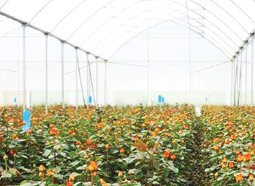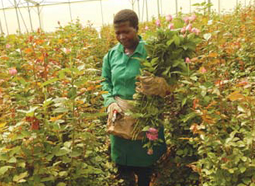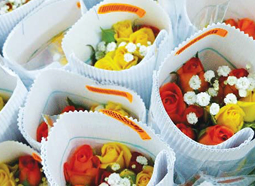 Changing market conditions
Changing market conditions
- Direct trade channels, bypassing the Dutch auction system, are on the rise
- Virtualisation of the trade
- Increased competition with Latin America in upcoming direct markets (Russia, Japan)
Factors For a Competitive Floricultural Business Environment (In No Particular Order)
| Macroeconomic Environment | Regulatory Business Environment | Broader Investment Climate |
|
|
|
 There is a general notice that the industry is changing dramatically. In recent years, consumption has stagnated in major markets, while the supply of flowers remained abundant. In the medium and long term, a moderate growth of only 2 to 4% annually is expected in Western Europe’s flower markets.
There is a general notice that the industry is changing dramatically. In recent years, consumption has stagnated in major markets, while the supply of flowers remained abundant. In the medium and long term, a moderate growth of only 2 to 4% annually is expected in Western Europe’s flower markets.
In the traditional florist channel, which continues to be the largest market segment, direct trade from producer to end market is increasing, particularly in those markets further away from the Netherlands.
In addition, the flower value chain is increasingly dominated by large and sophisticated European supermarkets and other mass-market retailers. This is resulting in a gradual shift of purchasing power from wholesalers and the Dutch auction system towards these mass-market retailers. Supermarkets tend towards single-sourcing, based less on price (as the Dutch auction system) and more on quality, delivery reliability and traceability. These large retailers are increasingly laying down quality standards, which are becoming more stringent and increasingly differentiated. Demand for sustainably produced and distributed products is rising.
There is also an acceleration of technology and knowledge development, not only in cultivation, but particularly in the way flowers are traded. More than 60% of the roses traded at the FloraHolland auction are sold through the remote buying system. European wholesalers offer products in their own online web shop, where customers (wholesalers and retailers) can buy directly from stocks. Trade becomes virtual making consistency and accurate exchange of information critical.
Margins under pressure
- Rising costs
- Need for continuous improvement
- Chain integration
In all producer countries, production and logistics costs are rising (labour, fuel, airfreight, inputs, energy, taxes, etc.), while prices will remain under pressure in the long run. As a result, margins are getting squeezed.
To remain competitive, farms are required to continuously improve their efficiency. This principle actually applies to the entire sector as a whole. Joint sector and public-private efforts are needed to gain efficiencies in the value chain.
The industry is evolving towards lean and transparent value chains characterised by consolidation and vertical integration.
 Challenges Facing the Sector
Challenges Facing the Sector
What determines the success of a national cut flower export sector, not only in Kenya, but in a number of leading flower producing countries. Some issues are typical for their local situation. Mostly, however, growers globally face similar issues, either production, logistics or marketing-related. For a large part, their success is determined by their entrepreneurial and growing skills. Still, literature and interviewed growers also agree that the business environment is a critical factor.
There are couple of big issues that way heavy on the competitiveness of the Kenyan flower industry such as political stability, safety, corruption and bureaucracy. One of the main daily concerns of growers, however, not only in Kenya but also abroad, are the ever rising costs. Rising costs are not only related to production factors as labour, energy and inputs, but also the costs of logistics and doing business in general.
Most relevant cost items:
- Production-related costs: labour, chemical inputs, energy
- Logistical costs: airfreight, packaging, paperwork, fuel
- Costs of doing business: taxes and levies, bureaucracy, security
As price levels remain under pressure and are not expected to rise, there is a clear need for efficiency improvement. Competing countries are moving forwards fast.
For the mid and long term future, there are five vital challenges for the Kenyan flower industry to retain or strengthen its competitiveness in the global flower markets:
- Efficiency improvement
- Sustainability
- Supply chain improvement
- Sector promotion
- Public sector
- coordination
Efficiency improvement
- Productivity
- Pest management
- Innovation
In terms of production costs, ample opportunities for efficiency gains exist. In the case of the costs of labour, the two main options are either to work on worker productivity and skills development or on mechanisation. As we have seen, skills level of Kenyan personnel is high by developing world standards and receives attention through education, practical training centre, etc. However, compared to Latin American and European competitors, there is still ample room for improvement. Furthermore, growers indicate that they believe they can further increase general worker productivity.
Note also the effect of a shift in rose assortment from small & medium-sized varieties towards larger rose varieties. In case of small to medium-size roses, labour costs comprise about 30 to 35% of total production costs, compared to only 20 to 25% in case of large varieties.
It has been identified a general lack of truly innovative enterprises. The most likely explanation for this is a combination of the traditional surplus of unskilled labour, a lack of access to adequate technology and knowledge institutes which have not been able to produce applicable technology for the local flower industry.
Some Kenyan farms experiment with mechanical grading and other forms of mechanisation. Many farmers, however, are hesitant if this is really appropriate technology for Kenya. At this stage, most Kenyan farms require mediumlevel technology, which is often not readily available.
Many administrative tasks on the farms are still carried out by hand and on paper. With the increasing importance of information and the move towards direct trade, farms will have to automate system administration to stay competitive.
Pest management practices and in particular an adequate application of chemicals in cultivation are other areas in which farms can further improve efficiency.
Sustainability Market requirements
- Compliance issues
- SME growers losing ground
Compliance to international standards regarding quality, workers’ health, safety and rights, and environmental sustainability are a precondition for European market access, particularly in the direct channel supplying mass market retailers. Majority of the growers are certified for one or more quality standards. Nevertheless, nationwide compliance is an issue and negative publicity is regularly the result.
What’s more, enforcement of government regulations like the environment-related NEMA licensing remains weak in Kenya. In other countries, a sound regulatory environment is combined with more stringent enforcement of government regulations.
Supply chain improvement
- Cold chain management
- Transport and logistics
- Packaging
- Handler performance
- Information and communication
Since flowers are highly perishable by nature, speed of delivery is critical, as are appropriate temperature control measures during transit. The strong growth in export volumes, however, has put pressure on the supply chain, creating bottlenecks that hinder efficiency and further development.
Studies show that there are many opportunities for efficiency gains along the entire value chain.
With the strong and continued development of direct marketing lines, Nairobi has the opportunity to develop into an important trading centre. Kenyan growers sell more flowers directly to customers in countries like Russia, Japan and the US.
Many supply chain inefficiencies are the result of a lack of communication and coordination between key actors in the supply chain. The industry has developed generally accepted ‘workarounds’ to bypass recognised problems, such as flight delays and flowers arriving at the airport at excessive temperatures. Furthermore, in the flower supply chain, neglect by one player typically leads to costs for somebody else.
Flying flowers to Europe is more costly than shipping them by sea. If successfully developed, sea transport can make Kenyan growers more competitive and can improve profitability. Sea transport trials have been carried out, but are not yet commercialised.
Sector promotion
- Country branding
- Export support
- Sector promotion
The flower export industry is highly internationalised. Kenyan growers increasingly face strong international competition from other leading producer countries, like Colombia, Ethiopia and Ecuador, who are aggressively expanding their markets.
Colombia’s Proexport is a good example of a public sector support organisation that contributes to the competiveness local export growers. Growers receive assistance in organising trade missions, but also through coordinated trade fair participations.
In all leading countries, private sector organisations are reasonably strong and active. They also enjoy a broad base among producers. Differences exist in the scope of services that these organisations provide. Some associations are very active in promotion, others more in aspects like advocacy, research, training, socioenvironmental issues or logistics.
A real challenge and source of future success for Kenya lies in a co-ordinated approach to create national product recognition in foreign markets. What is needed is a more sustained joint approach to international promotion by sector associations KFC and FPEAK, with HCD and EPC support. Actually, to effectively promote the Kenyan flower brand, Kenya needs one face to the world.
Public sector coordination
- Inconsistent taxes and levies
- VAT refund issue
- Fiscal incentives supporting innovative entrepreneurship
- Bureaucracy
- Coordination among public organisations
 Experience learns that the flower industry cannot be led by public initiatives alone. The primary role of the government should be facilitative and indirect (laws and regulation for foreign investment, intellectual property rights, technology transfer, air cargo licensing, foreign exchange transaction, etc.). Still, these are critical to the success of the sector.
Experience learns that the flower industry cannot be led by public initiatives alone. The primary role of the government should be facilitative and indirect (laws and regulation for foreign investment, intellectual property rights, technology transfer, air cargo licensing, foreign exchange transaction, etc.). Still, these are critical to the success of the sector.
Each country faces specific challenges that ask for targeted support and coordination. So is the case in Kenya. A specific issue in Kenya, for instance, is the decentralised system of taxation that often results in double taxation and inconsistencies.
The VAT rebate system is very inefficient and a burden to the industry. It is well known that nearly all produced flowers are exported, but at the same time, all growers must pay VAT on their input materials and afterwards submit a claim for a rebate, which usually is not paid back quickly enough.
We have seen that several other countries have put considerable efforts in reducing paperwork and bureaucratic overhead. Not only the environment for trade has been streamlined (by increasing the efficiency of customs), but also the tax system has become less complex.
A number of issues are often mentioned with respect to the various government bodies that are relevant to the flower industry. For instance, the costs (license fee, hiring experts, and required adjustments) and administrative burden related to the NEMA assessments are considered a burden for many growers. They, however, mostly complain about the costs related to required improvements, particularly expensive onsite water treatment plants. NEMA recognises this problem and in many cases a “negotiated compliance” is settled. The sector would gain if government institutions would be more familiar with the characteristics of the entire flower value chain, understand the market, and know how it affects the local export industry. Public services should be more in line with needs of private sector.
Technology and innovation are ever more important playing cards in the international competitive game. Growers should be backed by government incentives and well-developed agricultural research and development systems all striving to strengthen the knowledge and efficiency in the sector.
Way forward
Kenya is in a good position to grow into its role as a leading global flower supplier… but market conditions are changing dramatically and the competition is moving fast.
A coordinated effort by both government and private entrepreneurs is necessary. Both sides will need to work passionately and determinedly together to strengthen Kenya’s competitive advantages and to create an enabling environment in which export growers and industry service providers can thrive.
With the strong and continued development of direct marketing lines, Nairobi has the opportunity to develop into an important trading centre.
